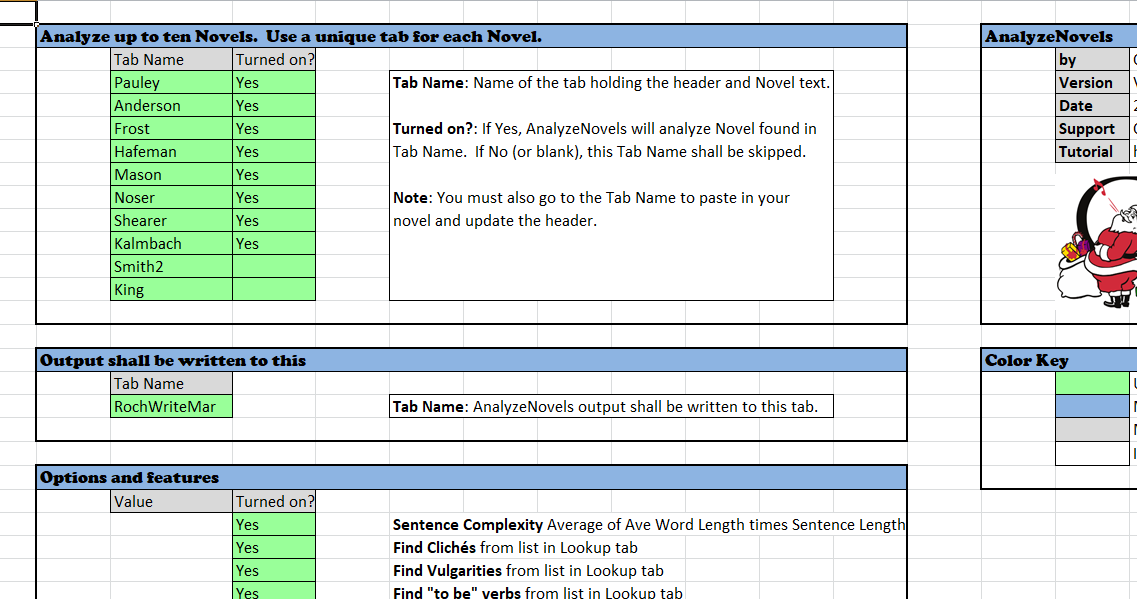Since the advent of the word processor, the only objective measure of a novel has been word count.
AnalyzeNovels seeks to expand this level of objectivity by simultaneously comparing (up to) 10 manuscripts against each other in over 20 different technical characteristics. The result? AnalyzeNovels produces intelligent graphs and charts that quickly identify the technical differences and/or similarities between novels. Not better, not worse -- just similar or different.
This can help you separate the wheat from the chaff (AnalyzeNovels finds clichés and reports on them, too!) when editing or reviewing a large manuscript, or a number of manuscripts.
And, better yet, AnalyzeNovels provides sorted reports allowing you to focus on the bigger problems, first.
Testimonial
|
I’m a new writer just completing my first novel. Brian ran my latest draft through his program. WOW, the search for overused words and phrases is wonderful. I didn't realize how many times characters were apologizing to each other until I searched on the word ‘sorry’. The analysis helped tighten up the prose in the final draft and saved me a ton of time, not to mention aggravation.
~ Ron Elcombe
|
Testimonial
|
Your program has found a number of areas where I need to tighten up my writing. It has picked up some weaknesses I didn't know I had. Very useful!
~ Jeff Johnstone
|
Testimonial
|
I have used Brian’s program more than once. He will run my novels in comparison to classic novels to help me improve my writing style. In addition, he saves all my previous submissions so he can compare it to my most recent submission. This gives me a snapshot of my improvement as a writer.
The program also reveals my problem areas, which helps me address issues to improve my writing. Good examples to illustrate this are the identification of over-used words and redundant phrases in my writing.
It has been a pleasure interacting with Brian as he shares his talents to help aspiring writers.
~ Dick Frost
|
Analyze Novels reports (charts and graphs) -- Example full report
- Character counts by novel.
- Word count by novel. This includes a count of all unique words (the vocabulary).
- The density of the unique words as a percentage of all words. Example: A Dr. Suess book will have low density of unique words. That is, the word vocabulary will be small, as it should be.
- The Average Word Length and the Longest Word. Example: Children’s books should have shorter words, on average.
- Count of the number of Words of a certain Length found in the Novel. Note: three-letter words are the most common followed by four, but this does vary by genre and author.
- Average Sentence Length Cadence (SLC) and Standard Deviation (SD). The SLC and SD both measure the varying lengths of sentences. Same length sentences are thought to be less effective in novels. The exception might be poetry. There, similar length sentences, yielding a lower SLC and SD, might be preferred.
- Number of short (1 to 5), medium (6 to 15), and long (15+ words) sentences.
- The Sentence Length 'Song'. This is a plot of the entire novel by the word-length of each sentence. Visually, allowing you to see the cadence (SLC).
- Average Sentence, Dialogue, and Narrative Lengths. Now, if we break the novel up into sentences of dialogue and narrative, we can see the average lengths of these sentences.
- Longest single sentence of Dialogue and Narrative. Finds the longest spoken sentence and the longest narrative.
- Longest uninterrupted Dialogue (the Monologue), Longest uninterrupted Narrative (the Epic).
- Words of Dialogue as a percentage of all words. Note: See the graphic above.
- Sentence Complexity. Longer sentences made from longer words yields more complex.
- Exclamation point counter. Warning! Too many can desensitize your reader! (for the times you really need them!) Honest!
- Adverb finder. Too many and your writing can be clunky. “Fred ran quickly.” versus “Fred sprinted.”
- Cliché finder. Too much of a good thing ...
- Vulgarity finder. As you might expect, Lady Chatterley's Lover (Lawrence) scores high.
- “To be” verb finder. These verbs are thought to be less effective than a more active verb.
- Overused word finder. Examples: that, just, start/started, eyes, face, expression, and many more.
- Filter word finder. Note: Filter words are those that unnecessarily filter the reader’s experience through a character’s point of view. Examples: Could, decided, felt, heard, looked, saw, sounded, thought, watched, wondered, and many more.
- Redundant phrase finder. Examples: absolutely essential, actual facts, stand up, sit down, single unit, nodded her head, continued on, both hands, and many, many more.
- Repeated phrase finder. A list of all the Repeated phrases between five and 99 words found in the Novel. For poems or children's books, repeated phrases might be a good thing (think Dr. Suess).
- Sorted list of unique words. Note: All the unique words in the novel sorted from the most frequent to the least.


